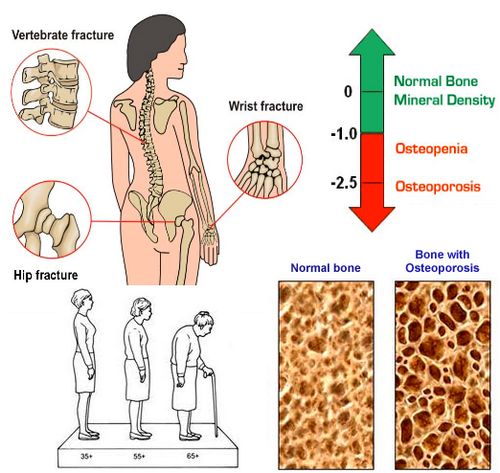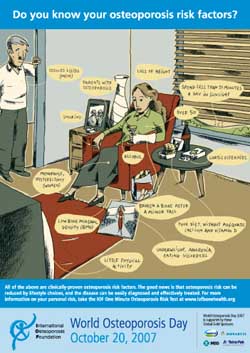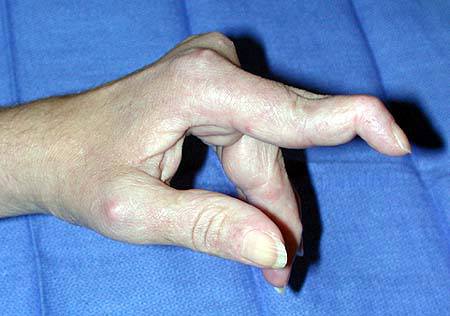Osteoporosis: Causes, Features, Prevention and Treatment

Osteoporosis is a condition characterized by increased porosity of the skeleton resulting from reduced bone mass – resulting in fractures. Throughout life, bones are continuously remodeled. While a child is growing, the rate of bone formation is greater than the rate of bone breakdown. The skeletal mass continues to increase until ages 20 to 30. Peak bone mass is achieved during young adulthood. After that, the rates of formation and breakdown of bone mass are equal until ages 40 to 50. Then, reabsorption begins to exceed formation, and the total bone mass slowly decreases. This age-related bone loss-averaging 0.7% per year is a normal biological phenomenon.
Over time, men are apt to lose 25% and women 35% of their bone mass. As quoted by Gro Harlem Brundtland “osteoporosis, as the third threat, is particularly attributable to women’s physiology”. But we have to consider that men tend to have denser bones than women anyway, and their testosterone (male sex hormone) level generally does not begin to decline significantly until after age 65. In contrast, the estrogen (female sex hormone) level in women begins to decline at about age 45. Because sex hormones play an important role in maintaining bone strength, this difference means that women are more likely than men to suffer fractures, involving especially the hip, vertebrae, long bones, and pelvis. Although osteoporosis may at times be the result of various disease processes, it is essentially a disease of aging.
Categorization of Osteoporosis:
A. Primary :
- Postmenopausal (Decreased serum estrogen)
- Senile (Aging and reduced physical activity)
B. Secondary :
1. Endocrine Disorders:
- Hyperparathyroidism
- Hyper/hypothyroidism
- Hypogonadism
- Pitiutary tumor
- Diabetes Mellitus type 1
- Addisons disease
2. Neoplasia:
- Multiple myeloma
- Carcinomatosis
3. GIT disturbances:
- Malabsorption
- Malnutrition
- Hepatic insufficiency
4. Drugs :
- Anticoagulant
- Corticosteroids
- Chemotherapeutics
- Anticonvulasants
5. Miscellaneous :
- Osteogenesis imperfecta
- Immobilization
According to German Anatomist/Surgeon Julius Wolff a bone is only big and strong as it has to be. This indicates the role of physical inactivity and immobilization in development of osteoporosis.
Signs and Symptoms:
Patients may not be aware of their osteoporosis until they suffer a painful fracture.
- Joint pains
- Backache
- Change in posture
- Loss of height due to repeated fractures of spine
- Dowager/Widow’s hump due to curvature of the spine at the shoulders in older people
- Hip and wrist fractures during fall
- Stress fracture during normal activity
Prevention and Treatment:
Everyone can take measures to avoid having osteoporosis when they get older. Adequate dietary calcium throughout life is an important protection against osteoporosis. Males and females require 1,000 mg per day until age 65 and 1,500 mg per day after age 65, because the intestinal tract has fewer vitamin D receptors in the elderly. A small daily amount of vitamin D is also necessary to absorb calcium from the digestive tract. Exposure to sunlight is required to allow skin to synthesize vitamin D. Therefore, you should avail yourself of the vitamin D in fortified foods such as low-fat milk and cereal. Postmenopausal women should have an evaluation of their bone density. Presently, bone density is measured by a method called dual energy X-ray absorptiometry (DEXA). This test measures bone density based on the absorption of photons generated by an X-ray tube. Soon, a blood and urine test may be able to detect the biochemical markers of bone loss, making it possible for physicians to screen all older women and at-risk men for osteoporosis.
If the bones are thin, it is worthwhile to take measures to gain bone density because even a slight increase can significantly reduce fracture risk. Regular, moderate, weight-bearing exercise such as walking or jogging is a good way to maintain bone strength . A combination of exercise and drug treatment, as recommended by a physician, may yield the best results. A wide variety of prescribed drugs that have different modes of action are available. Hormone therapy includes black cohosh, which is a phytoestrogen (estrogen made by a plant as opposed to an animal). Calcitonin is a naturally occurring hormone whose main site of action is the skeleton where it inhibits the action of osteoclasts (the cells that break down bone).
Promising new drugs include slow-release fluoride therapy and certain growth hormones. These medications stimulate the formation of new bone. Examples include Biphosphonates and Selective Estrogen Receptor Modulator (SERM).
Q: When is World Osteoporosis Day celebrated?
Ans: Every year on 27th October



